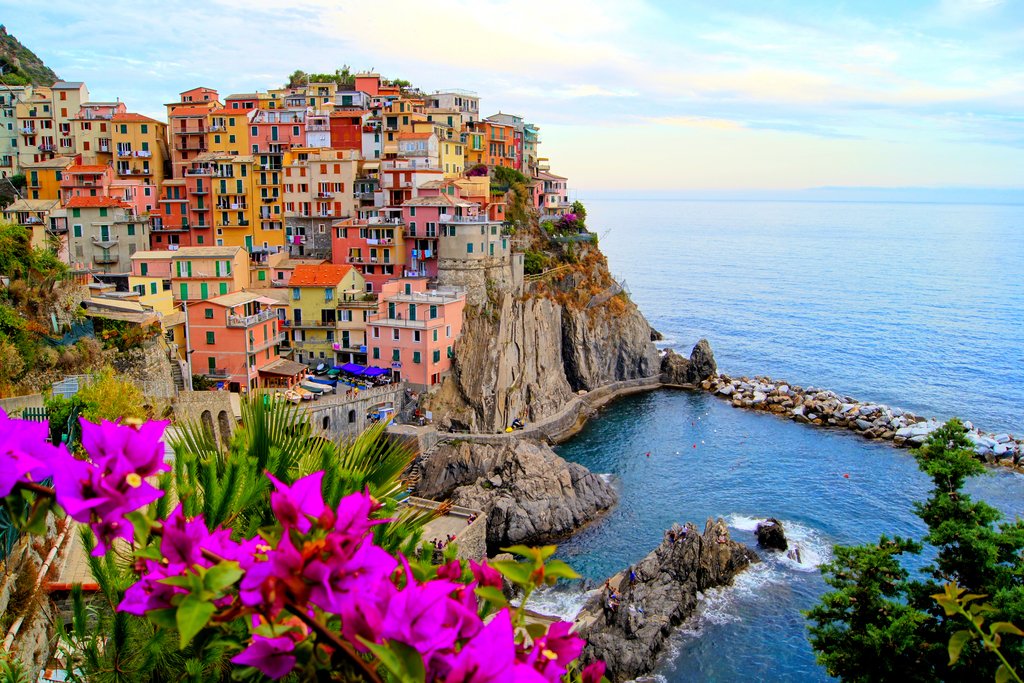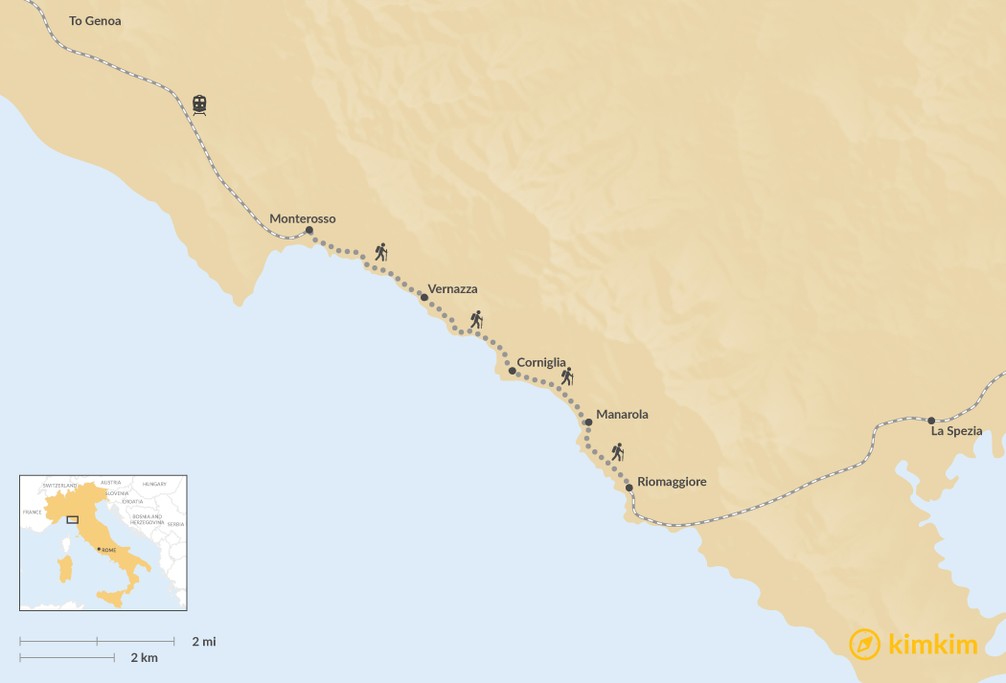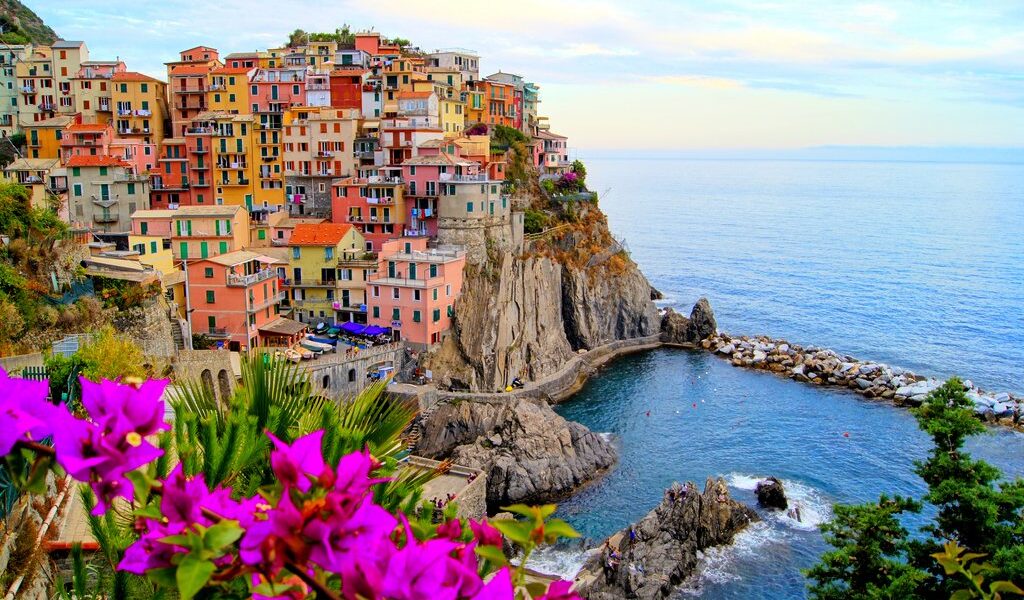
The five villages of the Cinque Terre are clustered on a terraced, hilly stretch of Italian Riviera coastline. Hiking between the centuries-old settlements is a popular summer pursuit, the steep footpath perpetually filled with camera-happy tourists. To beat the crowds, veteran travel writer Stephen Keeling attempts a February through-hike instead—all in just one day.
## The Enigmatic Trails of Cinque Terre: An Off-Season Adventure
“No,” she declared, her voice firm. “The trail is closed.”
The woman, stationed behind the Cinque Terre Information Desk, wielded her pen like a conductor’s baton, making dramatic crosses over each carefully marked section of the coastal trail on my detailed map. Her verdict was absolute and unwavering: “All closed.”
It was a deceptively bright February morning in Monterosso, a charming town nestled on Italy’s breathtaking Ligurian coast. The temperature hovered around a comfortable 52 degrees Fahrenheit, and the sky was an unblemished canvas of azure blue, devoid of even the slightest hint of a cloud. The woman at the desk, however, seemed unimpressed by the idyllic weather. She eyed my light jacket with a discerning gaze, perhaps questioning my preparedness for the elements, despite the sunshine. She herself was cocooned inside her booth, bundled in a heavy ski jacket, a snug hat pulled low over her ears, and a thick scarf wrapped tightly around her neck, a stark contrast to the mild weather outside.
Slightly bewildered, I made my way across the station hall to the Trenitalia ticket seller. Just moments ago, this same individual had confidently assured me that the trail was indeed open and accessible. “Yes,” he confirmed, his voice echoing in the spacious hall, “It’s open.” He then proceeded to inquire whether I was interested in purchasing a combined train and Cinque Terre Card, a seemingly straightforward transaction.
Confused by the conflicting information, I returned to the information desk, seeking clarification. The woman reiterated her earlier statement, her tone leaving no room for argument: the path was most certainly closed. Casting a hopeful glance back at the ticket seller, I sought some form of acknowledgment or explanation. However, he merely shrugged his shoulders, offering a nonchalant gesture that seemed to dismiss the discrepancy. He then repeated his sales pitch, inquiring if I still desired the Cinque Terre Card anyway, emphasizing that it was only 23 Euros, a seemingly insignificant amount.
Feeling increasingly perplexed, I stepped outside the station, seeking a more reliable source of information. My eyes fell upon an elderly gentleman, basking in the warm morning sun as he engrossed himself in the pages of an Italian newspaper. Ah, I thought, this is precisely the kind of local resident who truly possesses an intimate understanding of the area and its current conditions.
Summoning my courage and rudimentary Italian skills, I approached him cautiously. “*Scusi*,” I mumbled, my pronunciation undoubtedly flawed, “*sentiero di Vernazza aperto*?”
He looked up from his newspaper, his brow furrowed with confusion. “You asking about the trail to Vernazza?” he inquired, his English surprisingly fluent.
“Err, yes,” I replied, relieved to be able to communicate more effectively.
“I dunno. I’m from Milwaukee,” he confessed with a shrug. “But I *suspect* that it is open.”
The prospect of hiking the witheringly beautiful path – officially known as Sentiero Azzurro, No. 2 – along the Cinque Terre coast between Monterosso and Riomaggiore in the heart of winter presents a unique set of challenges and rewards. This approximately seven-mile hilly trek demands a certain degree of risk assessment and preparedness, but the potential pay-offs are undeniably considerable. It is generally advisable to avoid attempting the hike if it’s raining, as the region is prone to landslides, which can render the trails hazardous. However, when I journeyed down the coast from Genoa, the entire region was bathed in glorious sunshine, casting a golden glow upon the landscape.
Was the trail genuinely closed, as the woman at the information desk insisted? It was proving remarkably difficult to ascertain the truth. While there were indeed day-trippers milling around Monterosso, there were virtually no other hikers to be seen on the trails themselves. In the warmer months, the paths are notorious for becoming a series of single-file bottlenecks, choked with tourists eager to experience the beauty of the Cinque Terre. Each of the four official trail sections typically features manned checkpoints during the summer season, where officials are stationed to provide information and assistance. However, in the off-season months of winter, these checkpoints are unmanned, leaving visitors with no readily available source of guidance.
Despite the uncertainty and conflicting information, I ultimately made the decision to proceed. The allure of the trail, coupled with the enticing weather, proved too strong to resist.
## Monterosso to Vernazza: A Coastal Trek (2.3 miles)
Most guidebooks and travel resources will describe this particular section of the trail as being of moderate difficulty. However, the locals, who navigate these paths with effortless grace and familiarity, undoubtedly consider it to be an easy stroll. They seemingly zip up and down the slopes with the agility and endurance of sherpas, diligently tending to the terraced vineyards that rise up the hillsides like meticulously crafted layers of a gigantic chocolate cake.
Let me assure you, however, that this hike is anything but a piece of cake. Nothing quite screams “tourist” like the sight of someone stopping frequently to catch their breath, their face flushed and drenched in sweat, as a grey-haired man in a thick coat glides effortlessly past, casually carrying a small wagon on his back. The contrast is both humbling and amusing.
To be fair, the trail does indeed rise steeply from the beach in Monterosso, snaking its way through a diverse and captivating landscape of vineyards, fragrant evergreen olive trees, and carefully tended vegetable gardens. The path is remarkably narrow in certain stretches, consisting of a combination of mud and crumbling stone steps, demanding careful footing. Orange and lemon groves, enclosed within the protective embrace of medieval stone walls, are laden with an abundance of winter fruit in February, adding vibrant pops of color to the scene.
As you ascend, breathtaking views of the village of Monterosso and the surrounding coastline gradually open up below. You’ll catch glimpses of the Capuchin monastery perched on the other side of the bay, the inviting beaches stretching out along the shore, and the railway line, which, in the Cinque Terre, spends the majority of its time hidden beneath the earth.
Eventually, the trail rounds the rocky spur of Punta Corone, a prominent headland, and begins to flatten out, reaching an elevation of approximately 550 feet above the shimmering Ligurian Sea. Up here, the vegetation takes on a markedly different character, resembling more closely the arid landscapes of Baja California, with huge clumps of cacti and prehistoric-looking agave plants dramatically overhanging the cliffs.
During my hike, I encountered only a handful of other individuals. A couple of hikers raced past me downhill, their strides confident and swift. In the opposite direction, two smiling students were headed towards Monterosso, their faces flushed with exertion. Aside from these brief encounters, the trail was remarkably deserted, offering a sense of solitude and tranquility. The only sounds were the chirping of birds, the rustling of lizards in the leaves, and the occasional squawk of a seagull soaring overhead.
As you approach Vernazza, the trail begins to descend once more. Small patches of farmed plots reappear in the valley of the Riolo, signaling your proximity to civilization. A French family was enjoying a leisurely picnic in the lee of a small cliff, where a cluster of structures resembling “cat-houses” stand on the rocks. This is where the feral cats of Vernazza are fed and cared for by the compassionate locals.
From this vantage point, the views of Vernazza itself are nothing short of mesmerizing. It’s easy to understand why this village is widely regarded as the gem of the Cinque Terre, its beauty captivating all who behold it. The path gradually descends into the village, leading you behind the church of Santa Margherita d’Antiochia, a stunning 14th-century stone structure perched dramatically right on the harbor.
## Vernazza: A Pastel Paradise
Vernazza is indeed a gorgeous village, characterized by its collection of pastel-colored houses clustered around a sheltered cove. The main street follows the course of a river, now mostly hidden underground, adding to the village’s unique charm. I paused for a moment to savor a delicious espresso in one of the few open cafés on its tiny waterfront piazza. The café owner assured me that Vernazza is even more pleasant in winter, despite the village’s famed castle and many of its restaurants being temporarily closed.
Some tour groups do venture through Vernazza, even in the off-season month of February, but they typically arrive by train or coach. I didn’t observe anyone else actively hiking the trails. The village itself was buzzing with construction activity, the sounds of workmen echoing through the narrow streets, occasionally clashing with the half-hourly chimes emanating from the church. The Cinque Terre was clearly making a concerted effort to prepare for the anticipated summer deluge of tourists. *Pensiones* were being freshly painted, freezers and flat-screen televisions were being delivered, and paving stones were being meticulously fixed.
## Vernazza to Corniglia: Coastal Views and Olive Groves (2.6 miles)
The trail ascends steeply south of Vernazza, presenting a short but undeniably arduous climb. However, the effort is rewarded with breathtaking panoramic views. The path eventually levels off at an altitude of approximately 680 feet. At least this section of the path is comfortably wide, hemmed in by prickly pear cacti and agave plants, providing a sense of security. However, it’s easy to imagine that in the height of summer, this path would still feel quite cramped and crowded. The Ligurian Sea stretches out before you, seemingly extending for a thousand miles, the horizon broken only by a few ships glimmering like distant islands in the sun.
I encountered no other hikers on this stretch of the trail until I approached the tiny hamlet of Prevo, a charming cluster of villas perched high on the slopes. As the trail passed through a tranquil grove of olive trees, I spotted two farmhands taking a well-deserved break. I greeted them with a cheerful “*Buongiorno*,” and they nodded in reply.
“America?” the older man queried, his gaze inquisitive.
“*Inghilterra*” I replied, correcting his assumption. He frowned, perhaps unfamiliar with my homeland.
His cigarette hovered precariously over the can in his hand, which was labeled “ENI Benzina.” I watched as ash blew across the can, a potentially dangerous situation. I bid them goodbye and quickly continued my walk, eager to avoid any mishaps.
After an hour or so of hiking, the village of Corniglia came into view, perched dramatically on a hilltop like a medieval fortress. It’s the only Cinque Terre village that is not situated directly by the water. The path drops gently through dense, silvery olive groves and over a bridge spanning the grandly named Rio della Groppa (which is more of a rivulet than a river) before depositing me at the top end of the village.
As the afternoon wore on, I decided to continue my journey, walking through the village and around the charming little church of San Pietro e Paolo. From this point, you have the option to cut straight down to the coast and the railway station via the switchback staircase known as Lardarina, which comprises 365 “easy” steps, lined with vibrant big purple daisies. Below lies the train station, and clearly visible at the end of the bay, the next village of Manarola beckoned.
## Corniglia to Manarola: A Closed Path (1.3 miles)
A small group of tourists were waiting at Corniglia station, but none of them seemed to be planning on hiking to Manarola. The route appeared to be fairly easy, with no significant climb involved, just a path hugging the slopes above the shore for approximately a mile or so. I located the trail, but it looked totally abandoned, overgrown with thick grass and littered with debris. I strolled back to the station and encountered a man working on his car.
“Closed,” he said, his tone definitive. “Broken.”
This seemed like an authoritative answer. I lingered for a while, pondering my next move. The man looked up and simply said, “No.”
I finally conceded defeat and opted to take the train to Manarola. The official website later confirmed that the path had indeed been closed due to landslides. A mere three minutes on the train, and I found myself strolling through the long pedestrian tunnel that leads to the village of Manarola, another picturesque collection of painted houses set around a narrow cove.
I enjoyed a late lunch at the Marina Piccola, one of several appealing little restaurants facing a tiny blue harbor. The menu featured a delightful array of local seafood specialties, including anchovies, octopus, and cod, served in various rustic iterations of pasta, all of which were incredibly tasty.
## Manarola to Riomaggiore: Blocked by Landslides (.75 mile)
The final section of the coastal trail, stretching from Manarola to Riomaggiore, is generally considered to be the most popular. Giant signposts prominently advertise the route, which is a concrete, mostly level path known as the Via dell’ Amore (the Path of Love). It was hewn from the cliffs close to the water in the 1920s.
In the summer months, this part of the Cinque Terre becomes as congested as the Tokyo subway during rush hour, packed with tourists eager to experience its romantic allure. However, on this particular day, it was deserted. After walking for just a couple of minutes, I quickly realized why. The trail was physically blocked this time, by a sturdy steel barrier, a clear indication that it was impassable. I later learned that landslides were responsible for the closure. Riomaggiore was tantalizingly close, but once again, I was forced to resort to taking the train.
Riomaggiore proved to be a stunning place to take stock of my journey, looking back along the coast. Monterosso, my day’s starting point, seemed irritatingly close in the distance. The sea was a deep blue hue as the sun began its descent, casting a warm glow upon the landscape. Tiny fishing boats bobbed gently on the water, adding to the idyllic scene. Green hills loomed behind me, adorned with tiny statues of the Madonna tucked discreetly between the rocks.
I sought out a local café and ordered a refreshing beer. “Did you hike from Manarola?” the barman asked, his curiosity piqued. I explained that the trail was closed.
“No,” he insisted, his tone confident. “The trail is open!” He pointed along the cove to a path rounding the headland.
I glanced at my watch, finished my beer, and reluctantly began walking, wondering if I would ever find a definitive answer regarding the trail’s true status.
## Tips for Hiking Cinque Terre in Winter (and Summer)
It’s important to be aware that local trade union disputes can sometimes lead to the closure of the trail, which largely runs through Cinque Terre National Park. Additionally, landslides can physically block the path, as I discovered firsthand. Always check for the latest updates before embarking on your hike.
Trains (originating from Genoa or La Spezia) are undoubtedly the best way to access the Cinque Terre, as the roads in the area are narrow and exceptionally steep, making driving a challenging experience. Parking is a nightmare year-round, especially during peak season. Local trains are frequent, running every 10-30 minutes from early morning until late at night, and they stop at each of the five villages, providing convenient transportation.
When visiting Vernazza, consider dining at Taverna del Capitano on the main square (Piazza Guglielmo Marconi 21), which is usually open year-round. Also, don’t miss the opportunity to indulge in some delicious gelato at Gelateria Vernazza (Via Roma 13), which serves high-quality frozen treats even in the winter months.
In Manarola, Marina Piccola is located at Via Lo Scalo 16, near the harbor. In Riomaggiore the cafe I visited was Bar O’Netto Brasserie, at Scalinata della Tagliata 4.
During the summer, it’s essential to purchase a Cinque Terre Trekking Card to hike the coastal trail (7.50 Euros for one day; 14.50 Euros for two days). You can conveniently buy these cards online, at any of the local train stations, and typically at the small kiosks located at the trailheads in each village. The card also grants you free access to the bus services that operate between the village centers, providing additional transportation options.
The more expensive Cinque Terre Treno MS Card includes unlimited trips on local trains, offering greater flexibility for exploring the region. However, single tickets between each village rarely cost more than a few euros, so carefully consider your travel plans before opting for the more expensive card.

B-1386

